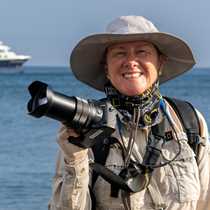Genovesa Island is unique. Even among the unusual islands of the Galapagos archipelago, the island is different – in form, in inhabitants. Genovesa sits north of the Equator with four other islands, the remaining islands rest on or below the Equator, in the southern hemisphere. The magma that formed Genovesa volcano isn’t solely derived from the hot spot mantle plume from the southwest, but mixed with spreading ridge material from the north where two giant tectonic plates are separating, slowly, many miles beneath the sea surface. Overall the island is flat and round, just over a million years old, but with relatively young lava flows of only around 10,000 years on top.
Genovesa is also home to almost 250,000 red-footed boobies, and probably the same number of frigates, although I haven’t seen an estimate given for the great frigatebird of this island. Innumerable swallow-tailed gulls breed here, as do the Galapagos storm petrels in the thousands, not to mention the terrestrial residents: short-eared owls, large cactus finches, warbler finches, Galapagos doves, vampire finches and Galápagos’ mockingbirds.
We wanted to see everything the island could possibly offer, and so from sunrise to sunset, we kept busy. As the day opened, those on the bow watched the captain guide our vessel into “Darwin’s Bay.” In itself, this is a spectacular geological formation: the crust of the island collapsed into an emptied volcanic caldera many millennia ago. The inside of the bay is too deep to anchor, over 600 feet in places. Only over to one side close to the beach can the National Geographic Endeavour anchor safely. However anywhere outside the bay we could anchor with ease, the sea floor around the island not reaching much over 100 feet.
Two landings, morning and afternoon, and a snorkel, kayak or beach visit before or after lunch filled the day admirably. As our last day in the archipelago, of course everyone wanted to do everything they could, within reason. The intrepid went for their last snorkel at the base of the cliffs in hopes of seeing a hammerhead shark – and a couple of people did! Moorish idols and the largest bumphead parrotfish of the archipelago were seen, as well as steel pompanos and a large school of golden rays! An exciting last swim, for sure.
Of course the highlights of our morning and afternoon shore visits were the fabulous boobies of Genovesa Island: Nazca and red-footed boobies were nesting everywhere. Nazca boobies with their stark white and black plumage are elegant (and noisy). The red-footed boobies have incredible face colors that amaze more than their feet. However a few great frigatebird males were still courting: red pouches inflated, bills clicking, warbling their intentions to be good mates to any female still available and interested.
Genovesa is a special island, a very special island, and we are indeed fortunate to be able to visit.




